
In an generation wherein the healthcare enterprise faces a deluge of cyber threats, the need for sturdy, adaptive, and smart security features has in no way been extra important.
With the upward thrust of digitized affected person facts, interconnected scientific devices, and telehealth answers, conventional network safety architectures often fall quick.
Enter Software-Defined Networking (SDN), a transformative technology poised to revolutionize cybersecurity in healthcare.
What is Software-Defined Networking?
Software-Defined Networking is an revolutionary approach that decouples the manage aircraft (selection-making method) from the statistics plane (actual information forwarding).
By the use of a centralized controller to control the network, SDN lets in directors to dynamically configure, monitor, and optimize network assets in actual-time.
This programmability is the important thing to its transformative capacity in cybersecurity.
Cybersecurity Challenges in Healthcare
Healthcare organizations face specific and evolving cybersecurity challenges:
- Proliferation of Connected Devices: From wearable fitness monitors to IoT-enabled surgical device, each connected device is a ability entry point for attackers.
- High-Value Data: Electronic Health Records (EHRs) are a goldmine for cybercriminals due to their touchy and precious nature.
- Legacy Systems: Many healthcare centers rely upon outdated software and hardware, which regularly lack present day security features.
- Compliance Requirements: Regulatory standards like HIPAA call for stringent statistics safety measures, growing the complexity of safety control.
How SDN Enhances Cybersecurity in Healthcare
1. Improved Network Visibility and Control
With SDN, administrators gain a centralized view of the community.
This holistic attitude allows real-time tracking of all site visitors flows, making it less difficult to detect anomalies and potential threats.
Healthcare businesses can pinpoint unusual hobby, such as unauthorized get entry to to scientific devices or big information transfers, and act straight away to mitigate dangers.
2. Segmentation and Isolation of Threats
SDN simplifies the implementation of micro-segmentation, a technique that divides the community into smaller, stable segments.
For instance, the network handling affected person information may be remoted from the only utilized by IoT gadgets.
If a breach takes place, the risk is contained in the compromised section, minimizing damage and preventing lateral movement across the network.
3. Real-Time Threat Response
The programmable nature of SDN permits dynamic policy adjustments.
When a potential attack is detected, the SDN controller can right away put into effect new safety policies, inclusive of rerouting traffic, quarantining inflamed gadgets, or blockading malicious IP addresses.
This rapid reaction capability is crucial for mitigating ransomware assaults and other fast-moving threats.
4. Enhanced Security for IoT Devices
Healthcare IoT gadgets are frequently inclined due to confined processing energy and outdated firmware.
SDN affords an delivered layer of safety with the aid of implementing strict get right of entry to control regulations and monitoring tool conversation patterns.
This reduces the chance of IoT-driven cyberattacks, along with botnet deployments or facts breaches.
5. Cost-Efficiency in Cybersecurity
Implementing SDN can lessen the want for expensive hardware enhancements and more than one standalone protection tools.
By centralizing manipulate and leveraging automation, healthcare corporations can acquire strong cybersecurity with out exorbitant costs, ensuring compliance with regulatory requirements with out straining budgets.
Real-World Applications of SDN in Healthcare Cybersecurity
Several healthcare institutions have begun adopting SDN to improve their networks. For instance:
- Hospitals: Use SDN to stable conversation among departments, making sure that touchy affected person statistics remains protected throughout transmission.
- Telehealth Platforms: Implement SDN to create stable, encrypted channels for health practitioner-patient consultations, safeguarding in opposition to eavesdropping.
- Medical Research Facilities: Leverage SDN to isolate studies records from public-going through networks, shielding highbrow belongings and touchy scientific trial facts.
Challenges to Overcome
While SDN offers sizeable blessings, its adoption in healthcare isn’t always without demanding situations:
Complexity of Integration: Transitioning from conventional networks to SDN calls for cautious planning and knowledge.
Skill Gap: Many IT teams in healthcare lack experience with SDN technologies, necessitating training or hiring experts.
Regulatory Hurdles: Ensuring SDN implementations follow stringent healthcare regulations can be complicated.
The Future of Healthcare Cybersecurity with SDN
As cyber threats grow more state-of-the-art, the agility and intelligence of SDN becomes vital for healthcare businesses.
By permitting proactive security measures, enhancing reaction instances, and optimizing useful resource allocation, SDN represents a paradigm shift in protecting touchy healthcare records and systems.
The avenue to vast adoption might also have hurdles, but the capability benefits of SDN some distance outweigh the demanding situations.
For healthcare providers, making an investment in this transformative generation is not just about staying ahead of cybercriminals—it is approximately safeguarding the consider and well-being of their patients in an an increasing number of related global.




